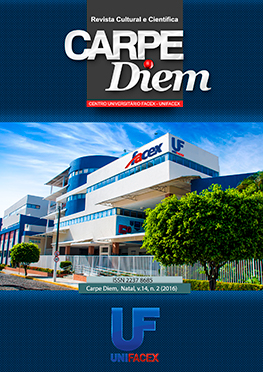EFFECT OF DIFFERENT LED WAVELENGTHS ON SURVEILLANCE CURVE OF ESCHERICHIA COLI AB1157 AND BW9091 WITH POSSIBLE GENOTOXIC ACTIONS
Palavras-chave:
LED, Escherichia coli, DNA, surveillance, healingResumo
Physiotherapy plays a function in the facilitation of repair process, once it utilized resources as laser and ultrasound therapy, sonic waves, microwaves and the phototherapy for processing the modulating repair. The utilization of the LED (Light Emitting Diode) in the wound healing process is based on its effects antibacterial, anti-inflammatory and cicatrization. The objective of this work is to investigate the effects of the LED of different wavelengths on surveillance of one cellular type proficient in repair DNA damage. It was used Escherichia coli (E.coli) strains proficient in repair DNA damage (AB1157) or not proficient (BW9091). Exponentially E. coli AB1157 or BW9091 cultures were incubated at liquid rich medium overnight. Aliquots were spread onto Petri dishes containing solidified rich medium and irradiated with LED of different wavelengths, the colonies units were counted after overnight and the survival fraction was calculated. The results show cytotoxic effect of blue LED on E. coli AB1157, and of the green and blue LEDs on E.coli BW9091. In conclusion, the results of bacterial surveillance showed cytotoxic effect manly for blue light (bacterial effect) and green light (anti-inflammatory effect).
Referências
Abramovits W, Arrazola P, Gupta A K 2005 Light-Emitting Diode-Based Therapy. Derm. Clin. 2005 38-40.
Almeida M C, Soares S F, Abreu P R, Jesus L M, Brito L C, Bernardo-Filho M 2007 Protective effect of an aqueous extract of Harpagophytum procumbens upon Escherichia coli strains submitted to the lethal action of stannous chloride. Cell Mol. Biol. 53 OL923-927.
Al-Watban F A H and Zhang X Y 1999 The acceleration of wound healing is not attributed to laser skin transmission. Laser Therapy 11(1) 6-10.
Bao M and Lou Y 2006 Flavonoids from seabuckthorn protect endothelial cells (EA.hy926) from oxidized low-density lipoprotein induced injuries via regulation of LOX-1 and eNOS expression. J. Cardiovasc. Pharmacol. 48 834-841.
Barbosa-Filho J M, Alencar A A, Nunes X P, Tomaz A C A, Sena-Filho J G, Athayde-Filho P F, Silva M S, Souza M F V, da-Cunha E V L 2008 Sources of alpha-, beta-, gamma-, delta- and epsilon-carotenes: A twentieth century review. Rev. Bras. Farmacogn. 18 135-154.
Corazza A V, Jorge J, Kurachi C, Bagnato V S 2007 Photobiomodulation on the angiogenesis of skin wounds in rats using different light sources. Photomed. Laser Surg. 25(2)102-6.
El-Demerdash F M, Yousef M I, Zoheir M A 2005 Stannous chloride induces alterations in enzyme activities, lipid peroxidation and histopathology in male rabbit: antioxidant role of vitamin C. Food Chem. Toxicol. 43(12) 1743-52.
Hsieh C L, Chen C L, Tang N Y, Chuang C M, Hsieh C T, Chiang S Y, Lin J G, Hsu S F 2005 Gastrodia elata BL mediates the suppression of nNOS and microglia activation to protect against neuronal damage in kainic acid-treated rats. Am. J. Chin. Med. 33 599-611.
Infanger D W, Sharma R V, Davisson R L 2006 NADPH oxidases of the brain: distribution, regulation, and function. Antioxid. Redox Signal. 8(9-10) 1583-96.
Kinoshita N, Hashimoto K, Yamamura T, Teranuma H, Koizumi T, Satoh K, Katayama T, Sakagami H 2005 Protection by antioxidants of copper-induced decline of proliferation and SOD activity. Anticancer Res. 25 283-289.
LeBlanc E, O’Connor E, Whitlock E P, Patnode C, Kapka T 2011 Screening for and Management of Obesity and Overweight in Adults. Evidence Report No. 89. AHRQ Publication No. 11-05159-EF-1. Rockville, MD: Agency for Healthcare Research and Quality.
Marcus D L, Strafaci J A, Freedman M L 2006 Differential neuronal expression of manganese superoxide dismutase in Alzheimer's disease. Med. Sci. Monit. 12 BR8-14.
Nicolau A, Dias N, Mota M, Lima N 2001 Trends in the use of protozoa in the assessment of wastewater treatment. Res. Microbiol. 152(7) 621-30.
Olinski R, Jaruga P, Zastawny T H 1998 Oxidative DNA base modifications as factors in carcinogenesis. Acta. Biochim. Pol. 45 561-572.
Ozben T 2007 Oxidative stress and apoptosis: impact on cancer therapy. J. Pharm. Sci. 96(9) 2181-96.
Pereira A N, Eduardo C P, Matson E, Marques M M. Effect of low-power laser irradiation on cell growth and procollagen synthesis of cultured fibroblasts. Lasers Surg. Med. 31 263-267.
Reddy G K 2003 Comparison of the photostimulatory effects of visible He-Ne and infrared Ga-As lasers on healing impaired diabetic rat wounds. Lasers Surg. Med. (New York) 33(5) 344-351.
Souza L L, Eduardo I R, Padula M, Leitão A C 2006 Endonuclease IV and Exonuclease III are involved in the repair and mutagenesis of DNA lesions induced by UVB in Escherichia coli. Mutagenesis 21 125–130.
Vasheghani-Farahani A, Kassaian S E, Yaminisharif A, Davoodi G, Salarifar M, et al. 2008 The association between coronary arterial dominancy and extent of coronary artery disease in angiography and paraclinical studies. Clin. Anat. 21 519–23.
Vinck E, Coorevits P, Cagnie B, De Muynck M, Vanderstraeten G, Cambier D 2005 Evidence of changes in sural nerve conduction mediated by light emitting diode irradiation. Lasers Med. Sci. 20(1) 35-40.


